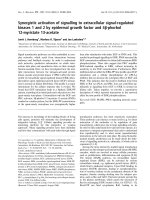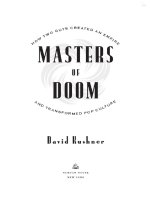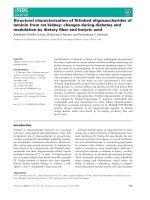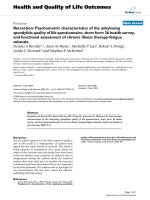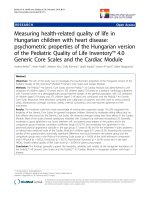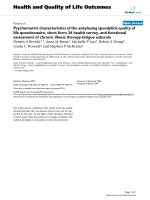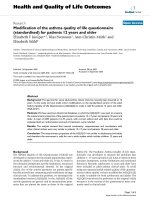Digital code of life how bioinformatics is revolutionizing science medicine and business by glyn moody
Bạn đang xem bản rút gọn của tài liệu. Xem và tải ngay bản đầy đủ của tài liệu tại đây (3.4 MB, 401 trang )
00_moody_ffirs.qxd 12/3/03 4:23 PM Page i
DIGITAL CODE
OF LIFE
How Bioinformatics is Revolutionizing
Science, Medicine, and Business
Glyn Moody
John Wiley & Sons, Inc.
00_moody_ffirs.qxd 12/3/03 4:23 PM Page i
00_moody_ffirs.qxd 12/3/03 4:23 PM Page i
DIGITAL CODE
OF LIFE
How Bioinformatics is Revolutionizing
Science, Medicine, and Business
Glyn Moody
John Wiley & Sons, Inc.
00_moody_ffirs.qxd 12/3/03 4:23 PM Page ii
Copyright © 2004 by Glyn Moody. All rights reserved.
Published by John Wiley & Sons, Inc., Hoboken, New Jersey
Published simultaneously in Canada
No part of this publication may be reproduced, stored in a retrieval system, or
transmitted in any form or by any means, electronic, mechanical, photocopying,
recording, scanning, or otherwise, except as permitted under Section 107 or 108 of
the 1976 United States Copyright Act, without either the prior written permission
of the Publisher, or authorization through payment of the appropriate per-copy fee
to the Copyright Clearance Center, Inc., 222 Rosewood Drive, Danvers, MA 01923,
978-750-8400, fax 978-646-8600, or on the web at www.copyright.com. Requests
to the Publisher for permission should be addressed to the Permissions Department,
John Wiley & Sons, Inc., 111 River Street, Hoboken, NJ 07030, 201-748-6011,
fax 201-748-6008.
Limit of Liability/Disclaimer of Warranty: While the publisher and author have
used their best efforts in preparing this book, they make no representations or
warranties with respect to the accuracy or completeness of the contents of this
book and specifically disclaim any implied warranties of merchantability or fitness
for a particular purpose. No warranty may be created or extended by sales
representatives or written sales materials. The advice and strategies contained
herein may not be suitable for your situation. You should consult with a professional
where appropriate. Neither the publisher nor author shall be liable for any loss of
profit or any other commercial damages, including but not limited to special,
incidental, consequential, or other damages.
For general information on our other products and services, or technical support,
please contact our Customer Care Department within the United States at
800-762-2974, outside the United States at 317-572-3993 or fax 317-572-4002.
Wiley also publishes its books in a variety of electronic formats. Some content that
appears in print may not be available in electronic books.
For more information about Wiley products, visit our Web site at www.wiley.com.
Library of Congress Cataloging-in-Publication Data
Moody, Glyn.
Digital code of life : how bioinformatics is revolutionizing science, medicine,
and business / Glyn Moody.
p. cm.
Includes bibliographical references and index.
ISBN 0-471-32788-3
1. Genetics—Data processing. 2. Genomics—Data processing. 3.
Bioinformatics. 4. Genetic code. I. Title.
QH441.2 .M664 2004
572.8—dc22
2003022631
Printed in the United States of America
10
9
8
7
6
5
4
3
2
1
00_moody_ffirs.qxd 12/3/03 4:23 PM Page iii
To our parents and children
00_moody_ffirs.qxd 12/3/03 4:23 PM Page iv
00_moody_toc.qxd 12/3/03 4:26 PM Page v
Contents
Preface
vii
Acknowledgments
ix
Chapter 1: The Code of Life
1
Chapter 2: Blast from the Past
11
Chapter 3: Genome Delight
37
Chapter 4: Speed Matters
55
Chapter 5: Science versus Business
79
Chapter 6: Showing the Data
105
Chapter 7: A Very Different Animal
129
Chapter 8: People’s Genes
159
Chapter 9: Getting Personal
185
Chapter 10: Free Expression
213
Chapter 11: The Common Fold
241
Chapter 12: The Promise of Proteomics
267
Chapter 13: Sum of the Parts
293
Chapter 14: Genomic Prescriptions
321
Further Reading
353
Glossary
355
Index
371
v
00_moody_toc.qxd 12/3/03 4:26 PM Page vi
00_moody_fpref.qxd 1/8/04 3:39 PM Page vii
Preface
Digital and analogue seem worlds apart. Digital is about a circumscribed set
of options and jumps between them, like the consecutive display of numbers
on a bedside alarm clock. Analogue, by contrast, is infinitely divisible, as
smooth as the movement of the hands on a traditional timepiece. Analogue
stands for the authentic, the natural, the vital; digital for the negation of
these: the artificial, the mechanistic, the dead. And yet, over the last 50 years,
a revolution in science has seen biology shift from an analogue approach,
built squarely on chemicals and their interactions, to an underpinning that is
thoroughly digital—one based on the information content of the genome, the
immense program stored in the cell’s DNA.
This book is about that transition, one of the most profound in history,
and about its implications for biology, medicine, healthcare, and everyday
life. Although the Human Genome Project—the international endeavor to
list completely the digital instructions stored in our DNA—played an important part in this shift, what follows is not a retelling of that story. Instead, it
is a history of how life became digital, and the rise of the discipline called
bioinformatics that helped make this happen, told largely through the words
of the scientists who had the original insights, created the new tools, and conducted the key experiments.
vii
00_moody_flast.qxd 12/3/03 4:25 PM Page viii
00_moody_flast.qxd 12/3/03 4:25 PM Page ix
Acknowledgments
One of the aims of this book is to introduce to a wider audience some of the
most exciting and important scientific literature to have been published during the last decade, by decoding it for the nonspecialist.
The vast majority of the papers discussed in this book are available online.
Some, like those describing the sequence of the human genome, are free;
others require a subscription to the journal in question. The preponderance
of papers from Nature and Science is explained by the fact that for some time
these titles have been the undisputed leaders in the field of scientific publishing. As a result, most of the key moments in genomics can be found in their
pages. This is fortunate, in a way, since both journals take considerable pains
to make their contents accessible to as wide an audience as possible. In the
hope that readers might be tempted to investigate the original sources and to
give credit for the passages that I have quoted, there are notes at the end of
each chapter. The book also contains suggestions for further reading, one or
two relevant Web sites, a glossary, and an index.
The unreferenced material is based on interviews conducted between
October 2002 and June 2003 with many of the leading figures in the world
of genomics, and my thanks go to them for their thoughts and time. I am also
grateful to Alan Moody for his technical advice and to those who have read
parts or the entire book in draft, particularly Anna O’Donovan and Sean
Geer. Naturally, all errors remain my responsibility alone. I would be
happy to receive corrections as well as general comments on the text at
My editor, Jeanne Glasser, played a key role in making this book happen,
and my thanks go to her for invaluable help and advice, and to her assistant,
Melissa Scuereb. I am also grateful to Todd Tedesco for steering the book
through production so efficiently, and to Matthew J. Kushinka for his sensitive copyediting. As ever, I owe my greatest debt of gratitude to my wife
and family, without whose constant support this book would not have been
possible.
GLYN MOODY
London 2003
ix
00_moody_flast.qxd 12/3/03 4:25 PM Page x
01_chap_moody.qxd 12/3/03 3:17 PM Page 1
CHAPTER
1
The Code of Life
T
he digital era of life commenced with the most famous understatement
in the history of science:
We wish to suggest a structure for the salt of deoxyribose nucleic acid
(D.N.A.). This structure has novel features which are of considerable
biological interest.
Thus began a paper that appeared in the journal Nature on April 25, 1953,
in which its authors, James Watson and Francis Crick, suggested the nowfamous double helix form of DNA. The paper was extraordinary in several
ways: first, because Watson and Crick, both relatively young and unknown
researchers, had succeeded in beating many more famous rivals in the race
to explain the structure of DNA. Second, their proposal managed to meld
supreme elegance with great explanatory power—a combination that scientists prize highly. Most of all, the paper was remarkable because it ended once
and for all decades of debate and uncertainty about the mechanism of inheritance. In doing so, it marked the starting point for a new era in genetics,
biology, and medicine—an era whose first phase would close exactly 50 years
after Watson and Crick’s paper with the announcement of the complete elucidation of human DNA. The contrast of that half-century’s dizzying rate of
progress with the preceding centuries’ slow groping towards an understanding of inheritance could hardly be greater.
1
01_chap_moody.qxd 12/3/03 3:17 PM Page 2
2
O
DIGITAL CODE OF LIFE
ne hundred and fifty years ago, Gregor Mendel, an Augustinian monk
working in what is now the city of Brno in Moravia, carried out the
first scientific investigations of heredity. Prior to his meticulous work on
crossbreeding sweet peas, knowledge about heredity had existed only as a
kind of folk wisdom among those rearing animals or propagating plants.
Mendel crossed sweet peas with pairs of traits—two different seed shapes
or flower colors—in an attempt to find laws that governed the inheritance of
these characteristics in subsequent generations. After thousands of such
experiments, painstakingly recorded and compared, he deduced that these
traits were passed from parent to offspring in what he called factors. Mendel
realized that these factors came in pairs, one from each parent, and that when
the two factors clashed, they did not mix to produce an intermediate result.
Rather, one factor would dominate the other in the offspring. The subjugated factor would still persist in a latent form, however, and might reappear in
subsequent generations in a remarkably predictable way.
Although it offered key insights into the mechanism of inheritance,
Mendel’s work was ignored for nearly half a century. This may have been
partly due to the fact that his work was not widely read. But even if it had
been, his factors may have been too abstract to excite much attention, even
though they turned out to be completely correct when recast as the modern
idea of genes, the basic units of heredity. In any case, work on heredity shifted to an alternative approach, one based on studying something much more
tangible: cells, the basic units of life.
Hermann Muller used just such an approach in 1927 when he showed that
bombarding the fruit fly with X-rays could produce mutations—variant forms
of the organism. This was important because it indicated that genes were
something physical that could be damaged like any other molecule. A chance
discovery by Fred Griffith in 1928 that an extract from disease-causing bacteria could pass on virulence to a strain that was normally harmless finally
gave researchers the first opportunity to seek out something chemical: the
molecule responsible for transmitting the virulence. It was not until 1944,
however, that Oswald Avery and his coworkers demonstrated that this substance was deoxyribonucleic acid—DNA.
In many ways, this contrasted sharply with the accepted views on the biochemical basis for heredity. Although DNA had been known for three quarters of a century—Johann Friedrich Miescher discovered it in pus-filled
bandages discarded by a hospital—it was regarded as a rather dull chemical
consisting of a long, repetitive chain made up of four ingredients called
nucleotides. These nucleotides consist of a base—adenine, cytosine, guanine
or thymine—each linked to the sugar deoxyribose at one end and a phosphate
01_chap_moody.qxd 12/3/03 3:17 PM Page 3
THE CODE OF LIFE
3
group at the other. Chemical bonds between the sugar and phosphate group
allow very long strings of nucleotides to be built up.
T
he conventional wisdom of the time was that genetics needed a suitably
complex molecule to hold the amazing richness of heredity. The most
complex molecules then known were proteins. They not only form the basic
building blocks of all cells, but also take on all the other key roles there such
as chemical signaling or the breakdown of food. It was this supposition about
protein as the chosen carrier for heredity that made Watson and Crick’s alternative proposal so daring. They not only provided a structure for DNA, they
offered a framework for how “boring” DNA could store inherited traits.
This framework could not have been more different from the kind most
researchers were using at the time. The key properties of a protein are its
physical and chemical properties; to use a modern concept, its essence is analogue. Watson and Crick’s proposal was that DNA stored heredity not physically (through its shape or chemical properties), but through the information
encoded by the sequence of four nucleotides. In other words, the secret of
DNA—and of life itself—was digital.
B
ecause it is the information they represent rather than the chemical or
physical properties they possess that matters, the four nucleotides can,
for the purposes of inheritance and genetics, be collapsed from the four bases
(adenine, cytosine, guanine, and thymine) to four letters. The bases are traditionally represented as A, C, G, and T. This makes explicit the fact that the
digital code employed by Nature is not binary—0 and 1—as in today’s computers, but quaternary, with four symbols. But the two codes are completely
equivalent. To see this, simply replace the quaternary digit A with the binary
digits 00, C with 01, G with 10 and T with 11. Then any DNA sequence—for
example AGGTCTGAT—can be converted into an equivalent binary
sequence—in this case, 00 10 10 11 01 11 10 00 11. Even though the representation is different, the information content is identical.
With the benefit of hindsight, it is easy to see why a digital mechanism for
heredity was not just possible but almost necessary. As anyone knows who has
made an analogue copy of an audio or video cassette from another copy, the
quality of the signal degrades each time. By contrast, a digital copy of a digital music file is always perfect, which is why the music and film industries
have switched from a semi-official tolerance of analogue copying to a rabid
01_chap_moody.qxd 12/3/03 3:17 PM Page 4
4
DIGITAL CODE OF LIFE
hatred of the digital kind. Had Nature adopted an analogue storage method
for inheritance, it would have been impossible to make the huge number of
copies required for the construction of a typical organism. For example, from
the fertilized human egg roughly a hundred thousand billion cells are created, each one of which contains a copy of the original DNA. Digital copying
ensures that errors are few and can be corrected; analogue copying, however,
would have led to a kind of genetic “fuzziness” that would have ruled out all
but the simplest organisms.
In 1953, computers were so new that the idea of DNA as not just a huge
digital store but a fully-fledged digital program of instructions was not immediately obvious. But this was one of the many profound implications of
Watson and Crick’s work. For if DNA was a digital store of genetic information that guided the construction of an entire organism from the fertilized
egg, then it followed that it did indeed contain a preprogrammed sequence of
events that created that organism—a program that ran in the fertilized cell,
albeit one that might be affected by external signals. Moreover, since a copy
of DNA existed within practically every cell in the body, this meant that the
program was not only running in the original cell but in all cells, determining their unique characteristics.
Watson and Crick’s paper had identified DNA as the digital code at the
heart of life, but there remained the problem of how this was converted into
the analogue stuff of organisms. In fact, the problem was more specific:
because the analogue aspect of life was manifest in the proteins, what was
needed was a way of translating the digital DNA code into analogue protein
code. This endeavor came to be known as “cracking the DNA code.” The
metaphor was wrong, though—perhaps it was a side effect of the Cold War
mentality that prevailed at that time. DNA is not a cryptic code that needs to
be broken, because this implies that it has an underlying message that is
revealed once its code is “cracked.” There is no secret message, however.
D
NA is another type of code—computer code. DNA is the message
itself—the lines of programming that need to be run for the operations
they encode to be carried out. What was conventionally viewed as cracking
the code of life was in fact a matter of understanding how the cell ran the
DNA digital code.
One step along the way to this understanding came with the idea of messenger RNA (mRNA). As its name suggests, ribonucleic acid (RNA) is closely
related to DNA, but comes as a single strand rather than the double helix. It,
too, employs a digital code, with four nucleotides. Thymine is replaced by
uracil and the deoxyribose sugar by ribose, but for information purposes, they
are the same.
01_chap_moody.qxd 12/3/03 3:17 PM Page 5
THE CODE OF LIFE
5
It was discovered that mRNA is transcribed (copied) from sections of the
DNA sequence. In fact, it is copied from sections that correspond to Mendel’s
classical factors—the genes. Surrounding these genes are sections of DNA text
that are not transcribed, just as a computer program may contain comments
that are ignored when the program is run. And just as a computer copies parts
of a program held on a disc and sends them down wires to other components
of the system, so the cell, it seemed, could copy selected portions of DNA and
send them down virtual wires as mRNA.
These virtual wires end up at special parts of the cell known as ribosomes.
Here the mRNA is used to direct the synthesis of proteins by joining together chemical units called amino acids into chains, which are often of great
length. There are twenty of these amino acids, and the particular sequence in
the chain determines a protein’s specific properties, notably its shape. The
complicated ensemble of attractions and repulsions among the constituent
atoms of the amino acids causes the chain of them to fold up in a unique form
that gives the protein its properties. The exact details of this protein are
determined by the sequence of amino acids, which are in turn specified by the
mRNA, transcribed from the DNA. Here, then, was the device for converting the digital data into an analogue output. But this still left the question of
how different mRNA messages were converted to varying amino acids.
A
clever series of experiments by Marshall Nirenberg in the early 1960s
answered this question. He employed a technique still used to this day
by computer hackers (where hacker means someone who is interested in
understanding computers and their software, as opposed to malevolent crackers, who try to break into computer systems). In order to learn more about
how an unknown computer system or program is working, it is often helpful
not only to measure the signals passing through the circuits naturally, but also
to send carefully crafted signals and observe the response.
This is precisely what Nirenberg did with the cell. By constructing artificial mRNA he was able to observe which amino acids were output by the
cell’s machinery for a given input. In this way he discovered, for example, that
the three DNA letters AAA, when passed to a ribosome by the mRNA, always
resulted in the synthesis of the amino acid lysine, while CAG led to the production of glutamine. By working through all the three-letter combinations,
he established a table of correspondences between three-letter sequences—
known as codons—and amino acids.
This whole process of converting one kind of code into another is very
similar to the process of running a computer program: the program lines are
sent to the central processing unit (CPU) where each group of symbols causes
certain actions that result in a particular output. For example, this might be
01_chap_moody.qxd 12/3/03 3:17 PM Page 6
6
DIGITAL CODE OF LIFE
a representation on a monitor. In the same way, the ribosome acts as a kind
of processing unit, with the important difference being that its output consists of proteins, which are “displayed” not on a screen but in real, threedimensional space within the cell.
Viewed in this way, it is easy to understand how practically every cell in the
body can contain the same DNA code and yet be radically different in its
form and properties—brain, liver, or muscle cells, for example. The DNA can
be thought of as a kind of software suite containing the code for every kind
of program that the body will ever need. Among this is operating system software, basic housekeeping routines which keep cells ticking over by providing
energy or repairing damaged tissue. There are also more specialized programs that are only run in a particular tissue—brain code in brain cells or
liver code in liver cells, for example. These correspond to more specialized
kinds of programs like word processors or spreadsheets: very often they are
present on a computer system, but they are only used for particular applications. The operating system, however, is running constantly, ensuring that
input is received from the keyboard and output is displayed on the screen.
The details of the analogy are not important; what is crucial is that DNA’s
information is digital. From this has flowed a series of dramatic developments
that are revolutionizing not just biology but medicine, too. All of these developments have come about from using powerful computers to search the digital code of life for the structures hidden within.
I
t may not be immediately apparent why computing power is important or
even necessary. After all, on one level, the totality of information contained within an organism’s DNA—termed its genome—is not complex. It
can be represented as a series of letters, turning chemicals into text. As such,
it can be read directly. This is true, but even leaving aside the problem of
interpretation (what these letters in a particular order mean), there is another fundamental issue that genome researchers must address first: the sheer
quantity of the data they are dealing with.
So far, the digital content of the genome has been discussed in the abstract.
To understand why computers are indispensable, though, it is helpful to consider some specific facts. For example, the DNA within a typical human cell
is twisted into a double helix; this helix is wound up again into an even more
convoluted structure called a chromosome. Chromosomes were first noted
within the nucleus of certain cells over one hundred years ago, but decades
were to pass before it was shown that they contained DNA. Normal human
cells have 46 chromosomes—22 similar pairs, called autosomes, and the two
sex chromosomes. Women have two X chromosomes, while men possess one
01_chap_moody.qxd 12/3/03 3:17 PM Page 7
THE CODE OF LIFE
7
X chromosome and one Y chromosome. The number is not significant;
chromosomes are simply a form of packaging, the biological equivalent of
CD-ROMs.
Even though these 46 chromosomes (23 from each parent) fit within the
nucleus, which itself is only a small fraction of the microscopic cell’s total volume, the amount of DNA they contain collectively is astonishing. If the DNA
content of the 23 chromosomes from just one cell were unwound, it would
measure around 1 meter in length, or 2 meters for all 46 chromosomes. Since
there are approximately one hundred thousand billion cells in the human
body, this means that laid end-to-end, all the DNA in a single person would
stretch from the earth to the sun 1,200 times.
Things are just as dramatic when viewed from an informational rather
than physical point of view. Each of the two sets of 23 chromosomes—found
in practically every human cell—makes up a genome that contains some 3 billion chemical digits (the As, Cs, Gs and Ts). Printed as ordinary letters in an
average-sized typeface, a bare listing representing these letters would require
roughly 3,000 books each of 330 pages—a pile about 60 meters high. And for
any pair of human beings (except twins deriving from the same fertilized egg),
every one of the million pages in these books would have several letters that
are different, which is why some people have brown eyes and others blue.
Now imagine trying to find among these 3,000 volumes the subprograms
(the genes) that create the particular proteins which determine the color of
the iris, say, and the letter changes in them that lead to brown rather than
blue eyes. Because genes have about 12,000 chemical letters on average—
ranging from a few hundred to a couple of million—they spread over several
pages, and thus might seem easy enough to spot. But the task of locating
these pages is made more difficult by the fact that protein-producing code
represents only a few percent of the human genome. Between the genes—and
inside them, too, shattering them into many smaller fragments—are stretches
of what has been traditionally and rather dismissively termed “junk DNA.” It
is now clear, however, that there are many other important structures there
(control sequences, for example, that regulate when and how proteins are
produced). Unfortunately, when looking at DNA letters, no simple set of
rules can be applied for distinguishing between pages that code for proteins
and those that represent the so-called junk. In any case, even speed-reading
through the pile of books at one page a second would require around 300
hours, or nearly two days, of nonstop page flicking. There would be little
time left for noting any subtle signs that might be present.
The statistics may be simplistic, but they indicate why computers have
become the single most important tool in genomics, a word coined only in
1986 to describe the study of genomes. Even though the data are simple
almost to the point of triviality—just four letters—the incomprehensible
scale makes manipulating these data beyond the reach of humans. Only com-
01_chap_moody.qxd 12/3/03 3:17 PM Page 8
8
DIGITAL CODE OF LIFE
puters (and fast ones at that) are able to perform the conceptually straightforward but genuinely challenging operations of searching and comparing
that lie at the heart of genomics.
T
he results of marrying computers with molecular biology have been
stunning. Just fifty years after Watson and Crick’s general idea for
DNA’s structure, we now have a complete listing of the human genome’s digital code—all 3 billion chemical letters of it. Contained within them are the
programs for constructing every protein in our bodies. There are instructions
that tell the fertilized egg how to grow; there are specialized programs that
create muscles, skin, and bone. As we begin to understand how this happens,
we can also appreciate how things go wrong. Like all software, the DNA code
has bugs, or errors, in it. Most of these are of no consequence, occurring in
noncritical places of the program. They are the equivalent of misspelled
words in the comments section of programming code. However, some errors
can be devasting. Consider the following two listings:
AGTAATTTCTCACTTCTTGGTACTCCTGTCCTGAAAGATAT
TAATTTCAAGATAGAAAGAGGACAGTTGTTGGCGGTTGCTG
GATCCACTGGAGCAGGCAAGACTTCACTTCTAATGATGATTA
TGGGAGAACTGGAGCCTTCAGAGGGTAAAATTAAGCACAGT
GGAAGAATTTCATTCTGTTCTCAGTTTTCCTGGATTATGC
CTGGCACCATTAAAGAAAATATCATCTTTGGTGTTTCCTA
TGATGAATATAGATACAGAAGCGTCATCAAAGCATGCCAA
AGTAATTTCTCACTTCTTGGTACTCCTGTCCTGAAAGATAT
TAATTTCAAGATAGAAAGAGGACAGTTGTTGGCGGTTGCTG
GATCCACTGGAGCAGGCAAGACTTCACTTCTAATGATGAT
TATGGGAGAACTGGAGCCTTCAGAGGGTAAAATTAAG
CACAGTGGAAGAATTTCATTCTGTTCTCAGTTTTCCTGGAT
TATGCCTGGCACCATTAAAGAAAATATCATTGGTGTTTCCTA
TGATGAATATAGATACAGAAGCGTCATCAAAGCATGCCAA
The two listings show only a tiny fraction of the 250,000 DNA letters that
code for an important human protein. The difference between the two portions of code is just three chemical letters—CTT is missing in the second listing. The absence of these three letters, however, is enough to result in cystic
fibrosis for many people who have this apparently trivial software glitch.
Similarly, just one wrong letter in another region can lead to sickle cell anemia, while the addition of a few extra letters in the wrong place elsewhere
01_chap_moody.qxd 12/3/03 3:17 PM Page 9
THE CODE OF LIFE
9
causes Huntington’s disease. Even more serious errors can mean embryos fail
to develop at all—a fatal flaw in the operating system that causes the human
system to crash as it boots up.
W
ith the cell’s digital code in hand, scientists can begin to understand
these problems and even treat them. Often a DNA software bug
causes the wrong protein to be produced by the ribosomes. Drugs may be
able to block its production or operation in some way. Similarly, knowledge
about the genomes of viruses and bacteria can aid pharmaceutical companies
in their search for effective drugs and vaccines to combat them.
Driving these developments is bioinformatics: the use of computers to
store, search through, and analyze billions of DNA letters. It was bioinformatics that turned the dream of sequencing the human genome into reality. It is bioinformatics that will allow humanity to decode its deepest secrets
and to reveal the extraordinary scientific riches contained in the digital core
of life.
NOTES
1. p. 7
2. p. 7
3. p. 7
4. p. 7
it would measure around 1 meter in length 20 facts about the human
genome. Online at />one hundred thousand billion cells in the human body 20 facts about the
human genome. Online at />facts.shtml.
genes have about 12,000 chemical letters Tom Strachan and Andrew P.
Read, Human Molecular Genetics 2 (1999): 150.
a word coined only in 1986 P. Hieter and M. Boguskis, “Functional
genomics: it’s all how you read it,” Science 278 (1997): 601–602.
01_chap_moody.qxd 12/3/03 3:17 PM Page 10
02_chap_moody.qxd 12/3/03 3:21 PM Page 11
CHAPTER
2
Blast from the Past
U
nlike DNA, with its neatly paired double helix, the history of bioinformatics involves many strands, often woven together in complex
ways. If the field has a point of departure, it can perhaps be traced to a
moment right on the cusp of computing history, and even before Watson
and Crick’s momentous paper. It was back in 1947 that a remarkable scientist called Margaret Dayhoff used punched-card business machines to
calculate molecular energies of organic molecules. The scale of these computations made the use of traditional hand-operated calculators infeasible.
Dayhoff’s conceptual leap to employing protocomputers as an aid showed
daring and doggedness—a calculation typically took four months of shuffling punched cards around—that was to prove a hallmark of her later career
in the world of DNA and proteins.
One of her main spiritual heirs and a key figure in the bioinformatics
world, David Lipman, has no doubts about her importance, telling me that:
“she was the mother and father of bioinformatics.” He bases this view on the
fact that “she established the three major components of what a bioinformaticist does: a mixture of their own basic discoveries with the data, which
are biological discoveries; tool development, where they share those tools
with other people; and resource development. She did all three, and she did
incredibly important things in all three.”
As the long list of her publications indicates, her main interest was in the
origin of life. It was the research into the evolution of biological molecules
that led her in 1961 to begin a lifelong study of the amino acid sequences that
make up proteins.
11
02_chap_moody.qxd 12/3/03 3:21 PM Page 12
12
DIGITAL CODE OF LIFE
Since proteins form the building blocks of life, their amino acid sequences
have changed only slowly with time. The reason is clear: any major difference
in sequence is likely to cause a correspondingly major change in a key biological function, or the loss of it altogether. Such an alteration would often
prove fatal for the newly evolved organism, so it would rarely be propagated
to later generations. By contrast, very small changes, individually without
great implications for biological function, could gradually build up over time
to create entirely new functions. As a result, when taken together, the slowly
evolving proteins provide a rich but subtle kind of molecular fossil record,
preserving vestiges of the very earliest chemical structures found in cells. By
establishing which proteins are related and comparing their differences, it is
often possible to guess how they evolved and to deduce what their common
ancestor was hundreds of millions of years ago.
To make these comparisons, it was first necessary to collect and organize
the proteins systematically: these data formed the basis of Dayhoff’s famous
Atlas of Protein Sequence and Structure, a book first published in 1965. Once
the data were gathered in this form, Dayhoff could then move on to the next
stage, writing software to compare their characteristics—another innovative
approach that was a first for the period. Thanks to this resource and tool
development, Dayhoff was able to make many important discoveries about
conserved patterns and similarities among proteins.
The first edition of the Atlas contained 65 protein sequences; by the time
the fourth edition appeared in 1969, there were over 300 proteins. But the
first DNA sequence—just 12 chemical letters long—was only obtained in
1971. The disproportion of these figures was due to the fact that at the time,
and for some years after, sequencing DNA was even harder than elucidating
the amino acids of proteins. This finally changed in 1977, when two methods
were devised: one by Allan Marshall Maxam and Walter Gilbert in the
United States, at Harvard; the other by Frederick Sanger in the United
Kingdom, at Cambridge. Gilbert and Sanger would share the 1980 Nobel
Prize in chemistry for these discoveries. Remarkably, it was Sanger’s second
Nobel prize. His first, in chemistry, awarded in 1958, was for his work elucidating the structure of proteins, especially that of insulin, which helps the
body to break down sugars.
A
s Sanger wrote in a 1988 autobiographical memoir aptly titled Sequences,
sequences, sequences: “I cannot pretend that I was altogether overjoyed by
the appearance of a competitive method. However, this did not generate any
sort of ‘rat race’.” Maybe not, but Sanger’s dideoxy method, as it was called,
did win in the sense that his rather than Gilbert’s turned out to be the key
sequencing technology for genomics, because it later proved highly amenable
02_chap_moody.qxd 12/3/03 3:21 PM Page 13
13
BLAST FROM THE PAST
to large-scale automation. It involved taking an unknown sequence of DNA
and using some clever biochemistry—the dideoxy part—to create from it four
sets of shorter subsequences, each of which ended with a known chemical letter (A, C, G or T). One group of subsequences consisted of a complete set of
progressively longer sections of the unknown sequence, each of which ended
in the letter A. Another group of partial sequences, all of which had slightly
different lengths from the first group (because for a given length there was
only one ending), ended in G, and so on.
For example, from the initial unknown sequence ATTGCATGGCTAC, the
dideoxy method would create three subsequences ending in A (A, ATTGCA,
ATTGCATGGCTA), three in G (ATTG, ATTGCATG, ATTGCATGG), three in C
(ATTGC, ATTGCATGGC, ATTGCATGGCTAC) and four ending in T (AT, ATT,
ATTGCAT, and ATTGCATGGCT).
Sanger ran these groups side by side through a gel slab (a special kind of
porous material) using an electric field placed across it. The field exerted a
force on the fragments, all of which carried a tiny electric charge. The various fragments moved through the gel at different speeds according to their
length. The shorter fragments were able to move more quickly through the
tiny gaps in the gel and ended up further down the slab. Longer ones had a
harder time squeezing through and were left behind by their smaller, nimbler
fellows, causing a series of distinct bands to appear across four lanes in the gel.
By comparing all four lanes together—one for each of the groups—it was
possible to work out the order of the chemical letters. In the previous example, the lane with all the fragments ending in A would show the band that was
farthest away from the starting point, so the first chemical letter was an A.
Similarly, the lane with the band slightly behind was in the T group, which
meant that the next letter in the original sequence was a T, and so on. The
overall result can be represented diagrammatically as follows, where the bands
are shown as asterisks (*):
Gel lanes:
A
C
G
T
Start points:
.
.
.
.
*
*
*
*
*
*
*
*
*
*
*
*
*
sequence reading
C
A
T
C
G
G
T
A
C
G
T
T
A


